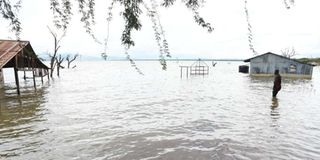Act now to save our forests, lakes in the Rift Valley

A submerged house at Kampi ya Samaki in Baringo County on May 04, 2020 after Lake Baringo burst its banks.
The Rift Valley lakes are submerging their environs, killing lives and livelihoods and there is a rising concern that the worst is yet to pass. There would be several reasons for this, as scholars have hypothesised. The tectonic movement conjecture is one of them.
Incidentally, tectonic movements that are robust enough to squeeze a lakebed must be felt in the form of earthquakes and tremors. This, thus, suggests that tectonism may not be the paramount culprit.
A more plausible factor may be the excessive rainfall the country is receiving, in light of the centripetal drainage pattern of Kenya’s Rift Valley. So much water is flowing into the lakes and very little of it is flowing out.
Principally, some of the lakes have no river outflows and most of them have subterranean conduits that evacuate their waters. Somewhere in the lakebeds, these underground drainage systems may be slatted by exceedingly slow tectonic compression or clogged by sediment overload, hence slow or no outflow from all the lakes at the same time.
A third factor that may be a force to reckon with is deforestation and the ensuing sedimentation of water bodies. Looking at satellite images of Kenya from the 1980s through to 2020, one can clearly see an adverse and steady reduction in Kenya’s green cover over the years.
In 1995, for instance, Kenya’s natural forests covered two per cent of the country’s total area, which is 11,607km2. In 2002, a Unep study on the Rift Valley lakes revealed that they were experiencing siltation resulting from deforested watersheds.
This submits that deforestation and siltation of the lakes has been going on for a long time and the situation may have been aggravated by population explosion and the need for extra land. Today, there is a propensity of people settling on previously unsettled wildernesses, including forest and shrub lands.
Massive afforestation
The highlands west and east of the Rift Valley are densely settled and cultivated. Conceivably, these are the homes of Kenya’s five main forests: Mt. Kenya, the Aberdare ranges, the Mau complex, Mt. Elgon and the Cherangani hills.
Presently, these natural forests cover a measly 1700km2, which is 0.29 per cent of Kenya’s total land area. Excessive deforestation is proportionate to enormous sedimentation of rivers and lakes. For the lake, it is like someone pouring a kilo of sugar into a tiny cup of tea, the tea will be displaced and will spill all around the cup.
Sediments are raising the beds of the Rift Valley lakes, pushing water off the lakes into the neighbourhood, where it causes mayhem. These same sediments may have sealed off underground drainage channels that ought to drain water off the lakes.
The lakes’ overflows are a rude reminder that massive afforestation is urgent and timely in Kenya. Forest reserves should be reforested, as wood lots, green belts/wedges, greenways, live fences, and grass terraces are created.
Perennial crops can replace grass crops on the Kenyan uplands, coupled with silviculture or tree farming. By all means, soil erosion should be controlled, all around the country and leadingly, in all agricultural regions.
Not taking any action to avert the effects of deforestation in Kenya will beget widespread desertification and desiccation of the Rift Valley lakes, which have been shallowed by sedimentation. Kenya must save her lakes by saving her forests and encouraging a greener use of the environment.





